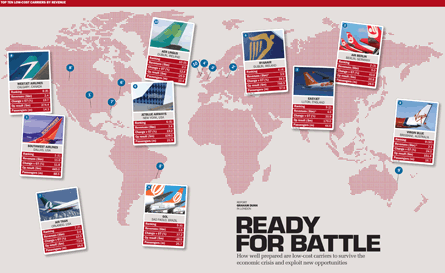In the first of a two-part feature, Spencer Stuart executives Michael Bell & Thierry Lindenau explore why low-cost chiefs are beginning to suffer legacy insomnia
What is keeping low-cost airline chief executives awake at night? Unfortunately, the answer is... everything. When asked what their biggest worries are, budget airline leaders respond with a virtual cornucopia of issues, enough to send any sane executive fleeing to another industry. The list is long: volatile fuel prices, credit card processor holdbacks, capital scarcity, softness in leisure markets, maturing markets, stunted growth, currency risks, industry convergence, increasingly competitive legacy carriers - and the growing pains that come with not being so young anymore.
Gone are the halcyon days of limitless growth and unbridled enthusiasm. Low-cost airlines around the globe are waking up daily to a new reality, with many of the same troubles their legacy carrier competitors face.
So what happened? And what's being done about it? What does the future hold for these airlines and their leadership?
If we turn the clock back, even as little as five years ago, the picture for low-costs around the globe looked much rosier. Established players such as Ryanair, easyJet, Virgin Blue, Southwest and JetBlue could virtually do no wrong as they found growth markets, and their legacy competitors, to be easy pickings.
In developing markets - Eastern and Central Europe, India, Southeast Asia and elsewhere - budget carriers were in vogue. Attracting start-up capital to launch in a virgin, untapped market was relatively straightforward and many an airline executive took flight to such markets to experience the dream and capture the proverbial pot at the end of the rainbow.
Now, those same markets are in virtual disarray. Eastern Europe's largest budget carrier, SkyEurope, is on the ropes; none of the Indian low-cost airlines are making money, despite a giant market, and the Russian marketplace shows little promise of success anytime soon.
The forces that underlie the troubled times in the low-cost sector are numerous. Here we examine a few of the key issues and how the sleep-deprived leaders are handling them.
No Man's Land
One of the issues facing certain budget sector players today is they find themselves in no man's land in terms of scale. They are large enough to require substantial new investments in critical infrastructure - such as information systems and corporate staff - to function smoothly, but insufficiently large to drive unit costs down to levels commensurate with healthy returns.
As former JetBlue senior vice-president sales & marketing, and now commercial advisor to AirAsiaX, Tim Claydon puts it: "The problem low-costs have nowadays is, in a word, growth. They geared their business plans for it, including major new aircraft deliveries, but now find themselves in the precarious position of not having attractive new markets to put those aircraft into.Yet they're of a size where they need new systems and processes to keep the business working properly and unfortunately those things cost money."
 |
|---|
"Size and age are both issues for low-costs. Reverse economies of scale come into play"Jason BitterChief executive, SkyEurope |
Jason Bitter, chief executive of embattled Central European budget carrier SkyEurope shares this concern:"Size and age are both issues for low-costs. Reverse economies of scale come into play. You gets some benefits of scale, but many of the problems as well. You lose the simplicity, and flexibility often goes out the door."
One silver lining, as Claydon sees it, is that the recent pause in growth budget players are experiencing "allows the airlines to slow down, consolidate and lay the foundation for the next phase of their development. That's a privilege few fast-growing companies get to enjoy, and one that low-costs would be wise to take advantage of."
Marketplace Convergence
One of the most troubling developments for the airlines and their leadership is marketplace convergence.
On many fronts - pricing, product offering, distribution, fleet, network design and even cost structure - the previously obvious and often blatant differences between budget and legacy carriers are now no longer so apparent. This has resulted from the movement of both parties in the same direction, toward the mainstream middle.
At one end, the passage of time has caused many low-cost airlines to partly or fully abandon the purist low-cost model on which they were established. Month by month, they are introducing more amenities in the cabin or on the ground as they attempt to lure increasingly fought after consumers, especially in the business segment. These include assigned seating, in-flight television and even meals.
While some of these are being put forward on an ancillary revenue basis, they are nevertheless adding complexity to a previously simple business model. Other players, such as JetBlue and Vueling, have begun tying into the global distribution systems or other traditional channels as a means of ensuring wider market access.
And whereas the historical hallmark of new low-costs was the single fleet type, many are now deploying at least two models, for examples JetBlue with Airbus A320s/Embraer 190s and Jetstar with A320s and A330s.
Others are working to tie their networks with legacy carriers to build feed, such as JetBlue with Lufthansa and Aer Lingus.Finally, with age has come cost and even otherwise efficient budget players are witnessing cost escalation in labour and other key categories.
 |
|---|
© Rex Features |
The move towards more mainstream models among low-costs has also been driven by the extension into long-haul flying. JetStar, AirAsia X and Virgin Blue's V Australia - all long-haul budget carrier extensions - offer some aspect of premium economy or business class and, in so doing, are venturing into the realm of added cost, not to mention the target of established long-haul network carriers.
Only a few carriers, Ryanair and Spirit for example, have stayed pure to the low-cost model, despite heavy pressure to go astray. Those two airlines have, in fact, continued to migrate to even more "fundamentalist" forms of the pure budget model, charging for things as basic as airport check-in (Ryanair) and drinking water on board (Spirit).
 |
|---|
"To succeed as a low-cost, you have to be a cost zealot and invest wisely"David HallExecutive manager corporate services and technology, Qantas |
Industry consultant Peter Harbison, the executive chairman of the Center for Asia Pacific Aviation, applauds the efforts of those who are putting the brakes on convergence."You've got to establish limits at some point or you'll eventually become a full service carrier. Many of those low-cost airlines which have installed in-flight entertainment systems are now removing them for lack of demand."
On the other end of the convergence phenomenon, legacy carriers have "woken up to smell the coffee" and now often look and feel more like their low-cost counterparts. This is occurring in one of three primary ways:
- Adjustments to the core mainline business
- The introduction of more aggressively priced or low-feature fare brands
- The purchase or development of budget subsidiaries.
On emergence from bankruptcy protection with a much-improved cost structure, Air Canada shut down its low-cost, low-fare "airline within airline", Tango, redefining it only as a fare brand. The airline also completely shut down its Western Canada low-cost carrier Zip, originally established to fight WestJet, concluding that its mainline costs were now competitive enough.
On the pricing side, many legacy carriers now boast no-frills or restricted fares across their networks as a means of fending off their budget rivals. Some have ventured to purchase or develop their own low-costs. That said, it is not clear that such moves have been overly successful, with a few exceptions. Jet Airways' purchase of Air Sahara, and its ensuing conversion and rebranding as JetLite, has yet to prove out. Observers point to Jet Airways' strong product focus as an issue, given management desire to introduce more amenities on JetLite, counter to common low-cost wisdom. It did not help, of course, that Air Sahara was not even a low-cost to start with.
Lufthansa Group's acquisition of germanwings is perhaps one of the more successful examples of a budget airline acquisition by a legacy carrier, with the parent deciding "if you can't beat them, join them". The move was clearly done as a defensive strategy, designed to preempt Ryanair from getting too large in Germany. In so doing, the purchase rounded out the group's portfolio to include a budget offering. Importantly, Lufthansa Group has not transformed germanwings into another Lufthansa, recognising that it is in a different business segment altogether.
Low-cost development is equally problematic and the airline graveyard is virtually littered with failed "internal low-costs": Tango and Zip at Air Canada, CALite at Continental, Delta Express and Song at Delta, Shuttle by United and TED at United, to name a few. History has shown the "airline within an airline" model rarely works well, particularly for low-cost carriers. That said, Qantas Group has done a commendable and perhaps the best job of launching and nurturing JetStar as a successful internal low-cost, without contaminating it with big airline issues.
 |
|---|
Click on the map to read more about low cost carriers |
So, as budget players have moved somewhat more mainstream, legacy carriers have equally begun to develop low-cost-like appendages.The result is what industry experts call convergence.Whereas this may have been inevitable, it is not good news for budget leaders as it makes it increasingly difficult to achieve differentiation and market profile. Faced with the prospect of earning frequent flyer miles on a large network carrier at pricing comparable to low-cost airlines, many consumers are voting with their feet.
Common Enemies
A pervasive theme shared by many frustrated budget carrier executives is that traditional industry threats are now the common enemy of all types of airlines, not just of those established decades ago. Examples include high and volatile fuel costs, slow-to-develop airport infrastructure and cyclical economies.
Much of the success of budget carriers has been predicated on achieving and maintaining industry-leading costs. As Enrique Beltranena - the chief executive of Mexican low-cost Volaris - rightly points out: "Lowest cost always wins." Recently departed Mandala Airlines chief executive and Ryanair veteran Warwick Brady shares that belief: " Age is definitely the enemy of the budget airline; it's just that low-cost carriers have just done a much better job at cost avoidance and aren't so wrapped up in customer service that they lose the focus on cost."
David Hall, former chief financial officer of JetStar and current executive manager corporate services and technology for Qantas, corroborates this view, adding that "to succeed as a low-cost carrier, you need to be a cost zealot and to learn to invest wisely".
A low cost base has most assuredly allowed budget airlines to fare well in better markets. But, in today's weak and volatile economy, even lowest cost may not be enough.
Many hedged fuel purchases in 2008 at levels well above the now-depressed market prices and are paying dearly for it. Others are finding that market stimulation through low prices pays much better dividends in a stronger economy; and they are rapidly discovering that there are indeed limits to the price elasticity of demand, particularly when jobs are being shed left and right.
Elsewhere, the turtle pace of infrastructure development is hurting low-cost growth. India, for example, simply does not have the airport capacity to handle the multitude of new budget players now operating there. AirAsia has been frustrated by government hurdles to the development of a new low-cost airport or terminal in Kuala Lumpur.
Labour unions, perhaps one of the biggest limitations on legacy carriers, are now also starting to sniff around low-cost airlines. JetBlue was the target of a major certification effort by the Air Line Pilots Association in the autumn of 2008. While it was not successful, it served to distract senior management at a highly inconvenient time as the market was going south. Even brand new Volaris has been the subject of unionisation threats, responding with employee-friendly actions such as company-wide employee vaccinations.
The Bank is Closed
One of the most troubling inhibitors in the low-cost industry today is access to financing. At virtually every turn, low-cost carriers are finding themselves turned away from new capital. There are few, if any, low-cost start-ups around today, given the understandable concern of private equity investors in what has proven to be a challenging sector. Many have been burned through investments in failed start-ups, such as Skybus in the USA, and are turning their investment portfolios toward more lucrative pastures.
Indications are that even those who are still in the game may be looking for graceful exits. Black Canyon Capital and Cyrus Capital Partners, the US private equity backers of Virgin America - Richard Branson's foray into the US domestic market - are reportedly looking to exercise the put options tied to their investments, essentially selling back their interest to Virgin. Of course, this is happening at the worst possible time. As a result, the airline has been forced to hire an investment advisor to help secure alternative equity investors or risk losing its operating certificate through violation of US foreign ownership restrictions.
Even carriers with sound economic fundamentals and consistent operating profitability, such as the trio backed by Indigo Partners - Spirit Airlines (US), Tiger Airways (Southeast Asia/Australia) and Wizz Air (Eastern and Central Europe) - have had to shelve their plans for initial public offerings given the virtual non-existence of the IPO market at this time. Others with healthy balance sheets and income statements cannot secure financing for new aircraft due to the credit crunch.
At every turn, it is clear to see that life in the low-cost sector is getting increasingly tough. The players are finding that the bank is virtually closed and the result is stalled growth, and possibly even contraction.
With the problems now clearly identified, in next month's issue Bell and Lindenau will evaluate potential solutions in the second and final part of this feature
 | Michael Bell, who previously spent six years with McKinsey, co-leads the global aviation practice of executive search specialist Spencer Stuart |
 | Thierry Lindenau is Brussels-based regional co-ordinator for Europe, Middle East and Africa at Spencer Stuart's global aviation practice |
Source: Airline Business























